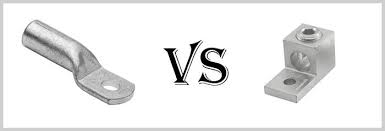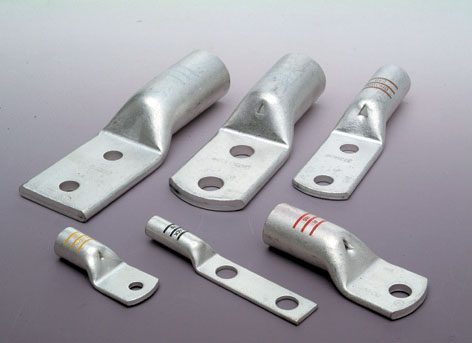In the backbone of electrical systems—from solar farms to data centers—terminal lugs serve as the critical link between cables and equipment. Yet, the choice between compression lugs and mechanical lugs is far from trivial: their technical design, performance, and durability directly impact system safety, efficiency, and long-term costs. As the global compression lug market gears up to hit $14 billion by 2026 (per Frost & Sullivan’s 2025 report), understanding their technical differences has become essential for engineers, contractors, and facility managers alike. Below, we break down the core technical distinctions that define when, where, and why each lug type excels.

The fundamental difference between compression and mechanical lugs lies in how they form a bond with cables—a choice that ripples through every aspect of their performance.
Compression lugs are engineered for permanent, gas-tight connections using a crimping tool. Their design features a hollow barrel (typically made of high-conductivity copper or tinned copper) that is compressed around the stripped cable, creating a circumferential, cold-welded bond. Key design elements include:
- Material Consistency: Barrels are often forged from single-piece copper (or aluminum for low-weight applications) to avoid weak points, with tinned or silver-plated finishes for corrosion resistance.
- Crimp Compatibility: Barrels are color-coded or marked with die indices (e.g., ABB’s Color-Keyed® system) to ensure matching with the correct crimping tool—critical for achieving uniform pressure.
- Low-Profile Build: Compact designs minimize space usage, making them ideal for dense electrical panels or tight equipment enclosures.
Mechanical lugs rely on screws or bolts to clamp cables in place, prioritizing adjustability over permanence. Their design includes:
- Clamping Mechanisms: Most feature two to four stainless steel bolts that compress a cable against a conductive base, with some models (e.g., PowerTemp’s Smart Lugs) adding oblong holes or spinning bolt tips to accommodate frayed wires.
- Reusable Construction: Unlike compression lugs, they can be disassembled and reinstalled—useful for applications requiring frequent cable modifications (e.g., temporary industrial setups).
- Material Tradeoffs: While often made of copper, their multi-piece design (base + bolts + clamping plate) introduces potential points of corrosion or loosening over time.
Technical specs separate reliable lugs from risky ones—and here, compression lugs consistently outperform mechanical alternatives in critical areas.
Resistance is the enemy of electrical efficiency: higher resistance leads to overheating, power waste, and premature failure.
- Compression Lugs: The cold-welded crimp creates a large, uniform contact area between the lug and cable, minimizing resistance. Tesla’s 2024 internal testing found compression lugs used in EV battery systems have resistance levels <15 μΩ—well below the IEC 61238-1 standard for “high-efficiency” connections.
- Mechanical Lugs: Bolted connections rely on torque to maintain contact, but even properly tightened lugs have higher resistance. The National Renewable Energy Laboratory (NREL) reported in 2024 that mechanical lugs average >25 μΩ—a 67% increase over compression lugs—due to small gaps between the cable and lug base.
In sectors like transportation (trains, EVs) or renewable energy (wind turbines), vibration can loosen connections—with catastrophic results.
- Compression Lugs: The permanent crimp acts as a “lock” against movement. Testing to Japan’s JIS C 2800 standard showed compression lugs withstand 9-level earthquake vibrations (equivalent to 0.8g acceleration) without resistance shifts.
- Mechanical Lugs: Bolted connections gradually loosen under vibration. UL’s 2025 report on electrical component reliability found mechanical lugs have a 5x higher failure rate in high-vibration environments (e.g., offshore wind farms) compared to compression lugs. Loose bolts create arcing risks, which were linked to the 2024 Tokyo subway fire.

Moisture, salt, and industrial chemicals degrade lugs over time—but design choices dictate longevity.
- Compression Lugs: Tinned or silver-plated barrels form a barrier against corrosion. 3M’s 2025 nano-coated compression lugs passed 2,000 hours of ISO 9227 salt spray testing with <0.01mm corrosion depth.
- Mechanical Lugs: Bolt threads and clamping gaps trap moisture, accelerating corrosion. A study by the International Electrotechnical Commission (IEC) found mechanical lugs in coastal solar farms show 0.05mm/year corrosion rates—5x faster than compression lugs.
The ease of installation and risk of human error further separate the two lug types.
- Tool Dependence: Requires specialized crimping tools (manual, hydraulic, or battery-powered) matched to the lug’s size and material. For example, Penn-Union’s compression lugs require die sets calibrated to ANSI C119.4 standards to avoid under- or over-crimping.
- Skill Gap: Proper crimping demands training— but once mastered, results are consistent. AutomationDirect’s 2025 field data found certified technicians achieve 99.2% crimp accuracy with compression lugs.
- Permanence Risk: Mistakes (e.g., using the wrong die) ruin the lug, requiring replacement— but this also prevents “quick fixes” that compromise safety.
- Tool Simplicity: Uses standard wrenches or torque screwdrivers, making them accessible for on-site repairs.
- Torque Sensitivity: Success depends on precise torque (typically 15–30 in-lbs for copper lugs). Schneider Electric’s 2024 research found 38% of mechanical lug failures stem from under-torquing (loose connections) or over-torquing (damaged threads).
- Reusability Tradeoff: While easy to adjust, repeated disassembly increases wear on bolt threads, reducing clamping force over time.

No single lug type fits all—technical differences dictate their ideal roles:
Compression lugs and mechanical lugs are not interchangeable—their technical differences translate to real-world impacts: compression lugs excel in reliability, efficiency, and durability for critical, long-term applications, while mechanical lugs offer flexibility for temporary or low-stakes uses. As regulations (e.g., California’s SB 1236, mandating compression lugs in new builds by 2026) and industry standards (IEC 61238-1:2025) shift toward higher performance, the choice becomes clearer: for systems where failure is not an option, compression lugs’ technical advantages make them the investment that pays off in safety, efficiency, and reduced maintenance costs.
For engineers and contractors, the takeaway is simple: match the lug to the application’s technical demands—not just its upfront cost. In the end, a lug’s true value lies in how well it avoids the costly consequences of resistance, vibration, and corrosion.







